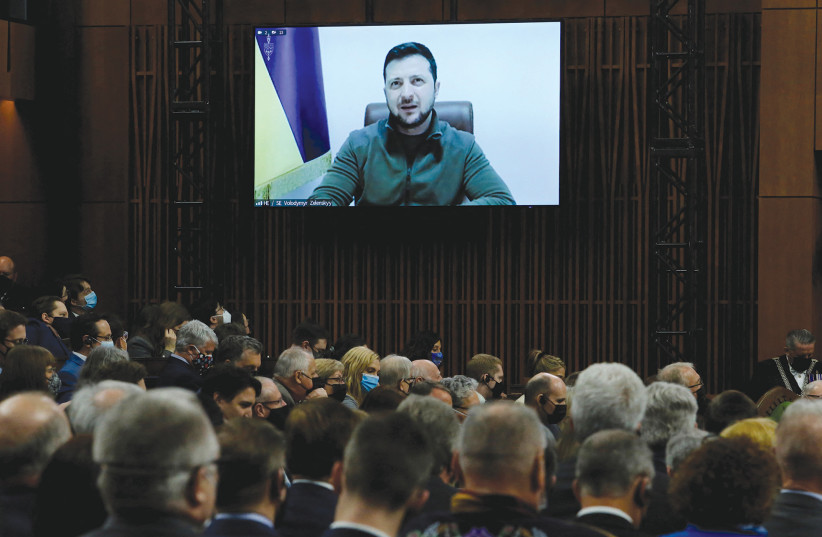In a speech he delivered to members of the Knesset, Ukraine President Volodymyr Zelensky made an analogy between Nazi Germany’s “Final Solution” to the Jewish Question and what he defined as Russian President Vladimir Putin’s final solution to Ukraine.
Furthermore, he made an analogy between the help that was supposedly afforded by the Ukraine people to Jews during the Holocaust and the aid Ukraine was expecting from Israel in its war against Russia.
That was not the first time that President Zelensky and Ukraine representatives had made use of historical analogies in order to elicit international support. Indeed, history and historical comparisons have played a central role in Ukraine public diplomacy.
In his speech before the House of Commons in Britain, Zelensky reminded his audience of the bravery of the British people during the Blitz, paraphrasing Winston Churchill’s “We shall fight on the beaches” speech. To the members of the United States Congress, he mentioned the Japanese attack on Pearl Harbor on December 7, 1941, and the terrorist attacks in the United States on September 11, 2001. Before the German Bundestag he made a speech alluding to the Berlin Wall in order to convey his message to the German public.
THE USE of historical comparisons in international diplomacy and in domestic politics in foreign-policy-related issues is hardly new. It didn’t commence with the Ukraine crisis of 2022, nor will it end with it. Historical analogy has been used in order to persuade.
Thus, for instance, Israeli politicians have made use of historical comparisons between Iran’s policy aimed at Israel’s destruction and Nazi Germany’s in the 1930s and 1940s.
It should be stressed that such a comparison has been drawn by politicians both from the Right (for instance, Benjamin Netanyahu) and from the Left (for example, Shimon Peres). Indeed, when Peres was asked once whether he truly believed that the Iranian regime was identical to Nazi Germany’s, he replied that his comparison did not refer to the nature of the regimes concerned, but to the policies adopted by democratic countries toward them.
When Egyptian president Gamal Abdel Nasser, nationalized the Suez Canal on July 27, 1956, sparking an international crisis, Anthony Eden, Britain’s prime minister, both in public and in private, made comparisons between Nasser and the dictators of the 1930s, particularly Benito Mussolini, arguing that the Soviet Union, Egypt’s ally, was akin to Nazi Germany. The comparison between Nasser and Adolf Hitler was quite common domestically, both in France and in Britain, also among left-wing politicians.
Historical analogy has been used also to inspire. For instance, during the First Gulf War, following Iraq’s invasion of Kuwait on August 2, 1990, and the subsequent military operation of the international coalition headed by the United States aimed at liberating Kuwait, Iraq attacked Israel with Scud missiles. Prime minister Yitzhak Shamir tried to inspire the Israeli people by drawing a comparison between what they were enduring and what the British people had to endure during the German Blitz in World War II.
Arab leaders used to compare Israel to the Crusades in order to inspire the Arab people facing defeat: Zionism and Israel would eventually be defeated and would disappear from the Middle East just as the Crusaders were defeated and disappeared in the Middle Ages. It might take a long time, but the Muslims – the Arabs – would ultimately prevail.
The aim of historical analogy, when used in public, is thus to persuade and/or to inspire.
THE HISTORICAL analogies drawn by the Ukraine leadership tend to be adapted to the audience concerned. Thus, the Holocaust is alluded to when speaking to the Israelis, the Blitz when speaking to the British, Pearl Harbor and 9/11 when speaking to the American people, and the Berlin Wall when speaking to the Germans.
The comparison made by Zelensky during his speech to the Knesset has produced, quite rightly, considerable indignation in Israel. However cruel the actions of the Russian army in Ukraine might be considered to be, to compare them to the Holocaust is historically spurious. To advance a distorted historical narrative of the Ukrainian people as a nation of Righteous Gentiles in order to request Israeli military assistance is also historically false.
The problem with Zelensky’s public diplomacy vis-à-vis Israel is that by being founded on a transparently distorted historical narrative, it creates a skeptical, if not altogether negative response.
In order to be effective, the use of historical comparisons in public should be the corollary of a reasoned and serious decision-making process. If taken lightly, it will backfire. The Ukraine example is a clear testimony to that.
The writer is a lecturer in international relations at Tel Aviv University. He holds a doctorate in modern history from Oxford University and a master’s degree from Cambridge University.

